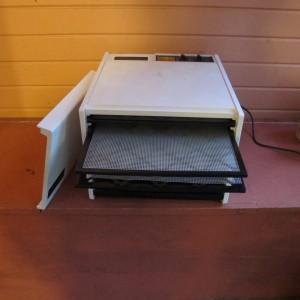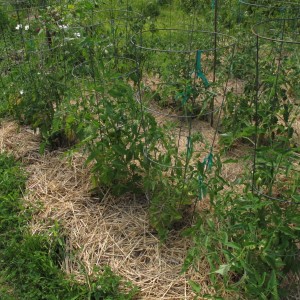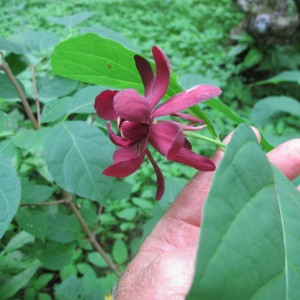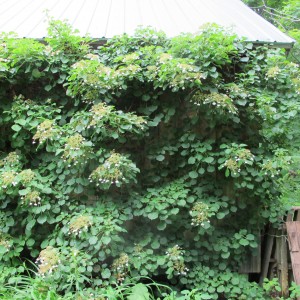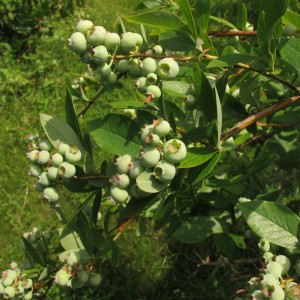Tomatoes
This has been, knock on wood, a great year for tomatoes. I planted my seeds indoors earlier than I usually do, which meant that my plants went in to the ground earlier, and bigger. And there were no late frosts, so I’m eating tomatoes earlier than most years. Cherry tomatoes started producing in early July, and I picked my first full sized tomato on July 16. Lots of sun and adequate rain have pushed them along. Barring an attack of late blight, I will have more than I need to feed myself all winter – if I process them now.
My mother and grandmother canned tomatoes. They worked in a hot kitchen in August and September turning homegrown tomatoes into canned tomatoes and sauce. In order to avoid the deadly disease, botulism, they boiled jars seemingly forever. But now, in the day of chest freezers, we can make sauce and not have to go through the canning process. You can make sauce and freeze it for use in the winter. And there are lots of other ways to save the harvest.
First, my favorite technique: freezing tomatoes whole. I call it the “no-work” method. Just place clean dry tomatoes in gallon freezer bags, suck out any excess air with an ordinary straw, and place the bags in the freezer on a cookie sheet. I generally get 9 large tomatoes into a gallon bag. After the tomatoes are frozen, you can take them off the cookie sheets and stack the bags.
When you are ready to use the tomatoes for a soup or stew, you can remove the skins easily, if you wish, by running them under hot water and giving them a quick rub. Halve the tomatoes and cut out their attachment points, chop and cook. If you let the tomatoes thaw they will be mushy and no good for sandwiches. But cooked? They’re great.
Last summer I tried roasting tomatoes in the oven, and was very pleased with the results. I cut tomatoes in half, and placed them in a shallow roasting pan and placed them in the oven at 350 degrees. I cooked them until the tomatoes caramelized and lost most of their moisture. Then I placed them in zipper bags, one layer thick and put them in the freezer. To avoid the need for scrubbing the roasting pan, I cooked them on a sheet of aluminum foil. These tomatoes worked fine in sandwiches in winter. I just put the frozen tomatoes in the toaster oven to thaw and heat, and put them on bread. Yum!
I grow a lot of cherry tomatoes each year – 10 plants or more. I eat them every meal in season, and snack on them between meals. My favorite variety is ‘Sun Gold’, a hybrid. What do I do with the vast numbers of these sweet cuties? For years I have been cutting them in half and dehydrating them. I’ve tried all sorts of dehydrators, and think I have found the best.
The machine I use is the Excalibur. This machine has 9 square trays, a heating element, a thermostat, a timer and a fan that sits behind the trays. The fan and heater location is key. This machine blows hot air across the trays as opposed to all the others I have used, which send hot air up from the bottom or down from the top. Either way, the tomatoes closest to the fan and heating element dry first, and those farther away dry more slowly. So one must rotate the trays, or take out the dry ones and continue to dry those that are still not fully dried.
The Excalibur also uses less electricity – 660 watts an hour, while the NESCO unit I used for years uses 1000 watts – but both take about the same time to dry a batch of tomatoes. The Excalibur also can hold more fruit per tray as the trays are square and the others are round.
I store the dried cherry tomatoes in zipper bags. They are fine on a shelf in the pantry, in the fridge, or, for long term storage, in the freezer. When I want to use them, I just toss them into a stir fry or stew, and these little nuggets bring a “Wow!” to the lips of my guests. If you don’t dry them to the crispy stage, but leave them a little chewy, you can even use them in salads and sandwiches.
Lastly, I make a lot of tomato paste. It’s easy and allows me to use chunks of tomatoes that had bad spots that needed to be cut out. I core tomatoes over the sink and squeeze out juice and seeds. Then I pop them into the food processor and puree them, skins and all. I pour the liquid into a heavy enameled cast iron pot, and slowly boil the slurry until it is thick enough to stand up a spoon in it. I let it cool all night, uncovered, and spoon the paste into ice cube trays. Once it’s frozen I bag it in zipper bags. Then I can get just the right amount of tomato paste and never waste any – I just use 1, 2 or 3 cubes, depending on my recipe.
It is still work to put up the harvest, but the methods above are a lot less work than canning tomatoes in jars in a hot –water bath. And come winter? There is nothing better than eating your own tomatoes.
Henry is the author of 4 gardening books and a children’s fantasy-adventure called Wobar and the Quest for the Magic Calumet. His web site is www.Gardening-Guy.com.
Mulching
I love the musical Porgy and Bess, especially the song, “Summertime,” with its catchy refrain, “Summertime and the livin’ is easy”. Clearly Gershwin was a) not a gardener, or b) he mastered the art of mulching. Mulching makes the summer easy, if done right. No mulch? The summer is spent weeding and watering. If you’re still weeding, it’s time to mulch.
My vegetable garden gets mulched in June as soon as the soil has warmed up. I take a sharp hoe and slice off any weeds in the walkways, and lay down 6 pages of newspapers. Then I cover the papers with mulch hay or straw. Straw is supposed to be free of seeds as it is the stems of oats or other grains that have been threshed. But I often find the straw germinates and sends up green shoots.
Hay, on the other hand, is grass that is grown for animal food and harvested with stems and seeds intact. But mulch hay is much cheaper than straw – a quarter the cost – and I find it doesn’t generate any more undesirable growth than straw. The fact that I lay down newspapers helps – it keeps the seeds out of the soil until the end of the season.
Big plants like tomatoes and broccoli get the same treatment as the walkways. I do leave some space right next to the stalk of each plant that gets no newspaper – so a light rain shower can get moisture to the roots. Little plants like onions or carrots get hay alongside their rows, but no newspaper. You could tear the papers and lay them down, and I have done it, but it isn’t worth the bother.
Leaves collected in the fall are excellent mulch. I run them over with the lawnmower, which makes them more compact and less likely to blow around. An inch of chopped leaves is an adequate layer of mulch. Pine needles are also good mulch, despite the fact that they have the reputation of being too acidic. In my experience they are fine – any biologically active soil with earthworms, fungi and bacteria will breakdown the needles over time without making your soil too acidic.
I don’t generally recommend using wood chips or shredded bark in the vegetable garden, but do use it in flower gardens. Vegetable gardens tend to have rows that move from year to year, and I don’t really want wood chips mixed into the soil. Flower gardens have more or less permanent plantings, and the wood chips stay put.
Some gardeners worry that the microorganisms breaking down wood chips will use up nitrogen from the soil, causing a nitrogen deficiency. If that were true, a lot of flower gardens would have flowers with yellowed, anemic-looking leaves. If you want, you can sprinkle a layer of organic fertilizer on the soil before you mulch. Organic fertilizers are made from natural ingredients such as seaweed, chicken litter, oyster shells, peanut hulls or other natural ingredients, and all break down slowly, which is an advantage in most applications – including under mulch.
Be advised that many of the wood or bark mulches sold in bags are “color enhanced”. That means they have used dyes of some sort to make the mulch dark – or even bright orange. I am an organic gardener, so I won’t use dyed mulch. I don’t know what is used to make the colors, so I avoid it. Many garden centers sell all natural mulch in bulk, which is much less expensive than buying it by the bag. All you need is a pickup truck – or a friend that has one. Cedar mulch is the most expensive, but I believe it lasts the longest before it breaks down.
Cocoa hulls are sold as mulch with very fine particles of organic matter. This mulch looks very tidy. Mostly. Usually some mold will appear on it after a couple of weeks, but then that goes away. And a nice layer of it will make your yard smell like you’re cooking brownies. That’s fine, but some dogs have been known to eat the cocoa mulch and get sick or even die. It’s probably not for homes with Labrador retrievers. And the mulch can be slippery when wet. Buckwheat hulls are another fine, fancy mulch. It is only sold in bags, and costs a fortune. I love the look, but can’t afford to use it.
Landscape fabric comes in a variety of types, all of which purport to keep down weeds and allow air and moisture to pass through. Fabric needs to be covered with mulch – generally wood chips – and I find that eventually some weeds grow in the mulch and get tangled in the fabric.
One final word of caution: don’t apply too much mulch. More is not better. Two inches of bark mulch is fine, but a five -inch layer will prevent moisture from getting to your soil in a light rain shower. And plants get their oxygen from the soil, so you don’t want to create a barrier that will keep gases from being exchanged. Mulch won’t control everything. Annual weeds? Yes. But established perennial weeds like goutweed or witch grass cannot be controlled with mulch. Still, mulch can save you lots of work and make the livin’ easy. Or easier, anyway.
Henry Homeyer is the author of 4 gardening books. His web Site is www.Gardening-Guy.com.
Good Bugs, Bad Bugs
Many gardeners seem to think that any UFI (Unidentified Flying Insect) is a potential threat to their tomatoes or the spinach. When in doubt, they swat it, squish it or submerge it. But most bugs are not bad – and many are helpful.
We all know that lady bugs are good. They eat aphids and in fact, some enterprising businesses are selling lady bugs by the thousand. My advice? Don’t bother buying them. If you’re not spraying your flowers and vegetables with insecticides, you will naturally have some ladybugs and other aphid eaters. Of course insecticides will throw off the balance of nature, and the pests may dominate. But a good healthy garden should attract beneficials like ladybugs in the quantities that you need. Bring in a thousand? They might fly away the same day.
According to the lovely little guide book, Good Bug Bad Bug: Who’s Who, What They Do, and How to Manage Them Organically by Jessica Walliser, a ladybug can eat up to 5,000 aphids in its lifetime. But there are plenty of other good bugs. This book, by the way, is simple, well illustrated and sturdy enough to take to the garden. I recommend it.
The assassin bug is just that: a voracious predator that will eat cabbage worms, potato beetles, cucumber beetles, cutworms, earwigs, Japanese beetles, Bean beetles, tomato hornworms, and more. They are generally black, and about half an inch long with a broad body and bristly front legs. They have a sharp curved beak they use to penetrate other insects, allowing them to inject a poison to kill them and turn their insides into a “smoothie” they can drink. They can sometimes pierce human flesh if handled roughly.
Lacewings are beautiful green flying insects with diaphanous wings. You’ve probably seen them on your window screens, attracted to the lights – they’re about an inch long. But it is their larvae that do they work in the garden – they eat about 100 aphids a day! The larvae are brown and white with big mandibles for grasping prey. They are half an inch long, and fast moving. The adults eat nectar and pollen of flowers and weeds including dandelions, Queen Anne’s lace and goldenrod so a few weeds are good to have – alonmg with plenty of flowers.
Parasitic wasps are generally small – from 1/32 of an inch to half an inch – but do great work. There are some 200 different kinds, according to Good Bug Bad Bug. Many have noticeable ovipositors for laying eggs, but don’t be confused and think they are stingers – these beneficial insects do not sting. They generally lay their eggs in the bodies, larvae or eggs of other insects. Once their eggs hatch, the young parasitic wasps feed on their prey.
One type of parasitic wasp feeds on the tomato hornworm. If you see small white “grains of rice” on the back of a hornworm, these are actually larvae of a wasp. Don’t kill the hornworm! Just move it off, away from your tomatoes, and let the wasp larvae do their thing. Like the lacewings, the adults feed on nectar and pollen, so a diverse garden with continuous blooms is a good attractant.
One of the things I like about the book Good Bug Bad Bug is that it offers many solutions to an insect problem. Row cover, a breathable spun fabric, is offered as a solution to striped cucumber beetles, and it reminds the reader that cukes are insect pollinated so you can’t keep it on once your vines start to produce blossoms. The book also suggests interplanting with marigolds, catnip or tansy or putting out yellow sticky cards to catch the culprits. Mulch, the book says, will help keep females from contact with the soil where they lay their eggs, too. I didn’t know that.
Potato bugs are my current nemesis. I plant my potatoes much later than my neighbors (in late June) which often means the bugs are already busy by the time my spuds come along. This year they have found me anyway. Every day I go down the row of potatoes, flipping the foliage over to look for adults and orange egg masses underneath the leaves. If I spot eggs, I remove that part of the leaf and put it in soapy water. This sounds tedious, but is actually just a 5 minute job for my 65 plants – and it makes a huge difference.
Diligence counts: I skipped a couple of days of patrol, and found potato bug larvae eating my plants. And picking 50 larvae is a lot more work than removing one leaf. So I shall keep up my vigilance. And if the larvae seem to be winning, I can always spray a biological control called Bt. This is a bacterium that will control them, but damage nothing else. But not all Bt is the same: ask for one that controls potato beetles (San Diego or tenebrionis).
Try to get over your aversion to bugs in the garden, if you have one. Just because a bug is unknown to you is no reason to squish it. It may be an assassin bug, ready to help you!
Henry Homeyer is the author of 4 gardening books. His Web site is www.Gardening-Guy.com. He is also a garden designer, gardening coach and public speaker.
Trees and Shrubs for the Shade
I grew up in a small town in rural Connecticut. Behind the house there was a brook and a hardwood forest with a high canopy of old maples that created a cool space for spending hot summer days. My favorite understory tree was a small, bushy tree that had very fragrant leaves and stems, which I decided must be witch hazel, as the barber splashed witch hazel on my neck after each haircut, and it was vaguely the same. I frequently chewed on the leaves and green twigs in lieu of the chewing gum that was forbidden to me.
This summer I discovered the name of that plant: spicebush (Lindera benzoin). One of my gardening clients had requested one for her garden, and as soon as I crushed a leaf, I was transported back 60 years. I knew it immediately. Most winters my part of New Hampshire drop to minus 25 degrees Fahrenheit, so any plant that will survive here must be rated for Zone 4 (Minus 20 to minus 30). I checked my favorite tree book (Michael Dirr’s Manual of Woody Landscape Plants), and sure enough, spicebush is rated for Zone 4. I will get my own as soon as I find the right place on my property to plant it.
From Dirr’s book I learned that spicebush can get to be up to 12 feet tall and wide, and is in the laurel family. There are 80 species of Lindera, both deciduous and evergreen (L. benzoin is deciduous). Apparently it blooms in early spring but the yellow blossoms are only one fifth of an inch across, so not overwhelming (I have no memory of it blooming). Fall leaf color is yellow. Dirr’s book says it does well in moist, well drained soils in full sun or half shade, though in my experience it will do well in dry shade in open woodlands. Dirr says spicebush is not often found in nurseries, but E.C. Brown’s Nursery in Thetford, VT has several nice ones.
Another woodland plant that I would like to try is leatherwood (Dirca palustris). Like spicebush, this is a native shrub that will grow in shady areas but this one prefers moist to wet soil – and I have plenty of that. Apparently it only gets to be 3 to 6 feet tall and wide, and is more open and spreading in shade than in sun. It is has small yellow flowers that bloom very early in the spring, well before the leaves emerge. Native Americans used the bark to make bow strings, fish lines and in the manufacture of baskets. Tough stuff.
Three years ago I planted a sweetshrub or Carolina allspice (Calycanthus florida). The first 2 years I grew it in full sun with deep, rich moist soil. Both years the leaves yellowed – as if the sun were too strong and bleached them out. So last fall I moved it into a grove of old wild apples that provide full shade, and it seems to be doing much better. It is blooming now, and has put on considerable new growth.
Sweetshrub grows to be 6 to 9 feet tall with a 6 to 12 foot spread. Some varieties have very fragrant flowers, but mine is not. Dirr’s book suggests buying the shrub is in bloom in early summer, as the fragrance varies from plant to plant. It is adaptable to acid or alkaline soils, and is hardy to Zone 4.
Mountain laurel (Kalmia latifolia) is another fabulous shrub that will grow in deep shade (or even full sun), and I have grown it these past 20 years or so, even though I am on the northern edge of where it is successful. Mine produces delicate three-quarter inch diameter flowers, cups of white with pink veins. After cold winters I don’t always get flowers. There are cultivars with flowers in white to rose, and everything in between. Definitely buy when blooming. It does best in acidic soil that is cool and lightly moist. I have seen it growing abundantly in the wild at Sleeping Giant State Park in Hamden Connecticut, where there is a high, dry, open hardwood forest.
Of all the shade-growing woody plants, the most dramatic on my property is the climbing hydrangea (Hydrangea anomala subsp. petiolaris). I have vines that completely cover the north side of my barn – and that only get a few hours of sun each day. It is in bloom now, with flower corymbs (flat topped inflorescences) that have both fertile and sterile (showy) blossoms and are 6 to 10 inches across.
Climbing hydrangea is slow to get established – mine took 6 years – but once it begins to grow, it quickly covers a surface. It will attach itself to stone or brick, but needs to be strapped onto wood surfaces, at least at first. Mine has grown through the cracks on the barn and is now self-supporting. Its vines can grow 60 feet or more, and has support arms for its flowers that reach straight out from the barn that are up to 3 feet long. It is truly dramatic.
So don’t despair if your property is mostly in the shade. There are these plants, and lots more, that will amaze and delight you.
Henry Homeyer is the author of 4 gardening books. His Web site is www.Gardening-Guy.com.



